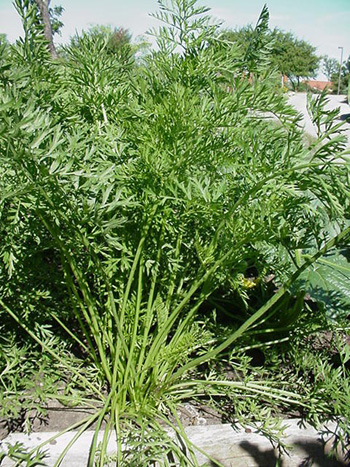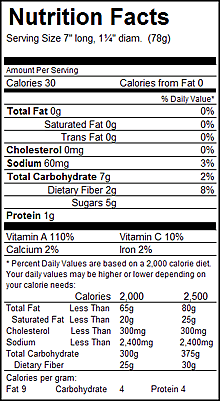Contents:
Common Names | Parts Usually Used | Plant(s) & Culture | Where Found | Medicinal Properties | Biochemical Information
Legends, Myths and Stories | Uses | Formulas or Dosages | Nutrient Content | Warning | Resource Links | Bibliography
Scientific Names

- Daucus carota L.
- Umbilliferae
- Umbel family
Common Names
- Bee’s nest plant
- Bird’s nest
- Bird’s-nest root
- Devil’s plague
- Garden carrot
- Hu-lo-po
- Queen Anne’s lace
- Wild carrot
Parts Usually Used
Root (cultivated), seed (wild)
Back to Top

Description of Plant(s) and Culture
Carrot is an annual or biennial plant 2-4 feet tall. The wild carrot has a tough, white, inedible root. The stem of the carrot plant is hairy and branched, the leaves bipinnate and cut into fine divisions. The lacy, white flowers appear in a flat cluster, with 1 small deep purple floret at the center; 3 forked bracts beneath; blooms from April to October. The seeds are of a dull brown color, flat on one side and convex on the other.
Back to Top
Where Found
Widely cultivated and also found wild in farmlands, pastures, waste places, roadsides, and meadows. Throughout the United States.
Back to Top
Medicinal Properties
Anthelmintic, carminative, deobstruent, diuretic, stimulant
Back to Top
Biochemical Information
Volatile oil and other unidentified constituents, doucorin, potassium, vitamins A and C, carotene
Back to Top
Legends, Myths and Stories
Wild carrot is considered a very common weed. Proper identification is essential to make sure this plant is not mistaken for one of the deadly poisonous members of the carrot family (Umbelliferae).
Carrot poultice: boil carrots until soft, or they can be used raw. Mash to a pulp, add some vegetable oil to keep them from hardening, spread on a cloth, and apply. Excellent for offensive sores. Garden carrots, grated raw, and applied as a poultice, will cleanse old sores and ulcers. Follow with an application of healing lotion or a wash of golden seal and myrrh solution.
Daucus, from the Greek daukos, or daukon–a kind of carrot–a genus of about 60 species of annual, biennial or perennial herbs mainly of Mediterranean and African distribution, belonging to the Umbelliferae family. The biennial Wild carrot is a naturalized herb in America, found growing in old meadows and pastures. It cannot be transplanted into the garden to produce an edible product. It taints milk with a bitter flavor if cattle eat too much of it, although it is not poisonous.
Eating a raw carrot a day can reduce the risk of getting certain forms of cancer. Cancer researchers have found that eating 12,500 IU of beta carotene, a plant form of vitamin A, daily (there are 13,500 IU in one raw carrot) can prevent cancers of the esophagus, stomach, intestines, and prostate. Numerous studies worldwide, including some sponsored by the National Cancer Institute, confirm that people who eat diets high in carrots and other foods rich in carotene are less likely to develop certain forms of cancer than those who don’t. The studies show that even people exposed to specific carcinogens such as tobacco and ultraviolet light could reduce their risk of cancer by eating more carotene.
The RDA (recommended daily allowance) for carotene is 5,000 IU, but cancer researchers suggest that in order to dramatically decrease the cancer risk, 12,500 IU of carotene is sufficient. Also, carrots are excellent for the eyes and helps counteract night blindness and weak vision.
Three large raw carrots a day may also lower blood cholesterol levels, thus reducing the risk of developing coronary artery disease, the leading cause of heart attack.
The fresher the product the better; from the minute the carrot is picked, the carotene begins to lose its potency. Try to buy loose carrots from the grocer and avoid the stuff that is sold in plastic bags. Use them as quickly as possible.
Back to Top
Uses
Carrot soup makes an effective remedy for diarrhea and is easily digestible for those suffering from stomach and intestinal problems. Carrot is useful for preventing putrefaction in the intestine and for gastro-intestinal catarrh.
The carrot’s content of potassium salts accounts for its diuretic action, and it contains an essential oil that is effective against roundworms (east 2-3 raw carrots a day for several days). Take carrot juice for stomach acidity and heartburn. Carrots are good for the eyes; specifically, their carotene content provides the material for the body to make vitamin A, which is important for proper vision and night vision. An infusion or decoction of the seeds of wild carrot can be used for flatulence, as a diuretic, and to promote the onset of menstruation.
It treats fluid retention, chronic urinary tract problems, gout, jaundice, dysentery, cystitis, rheumatism, hiccoughs, chronic coughs, gall stones. Science confirms its bactericidal, diuretic, hypotensive, worm-expelling properties. Culpeper claims that carrot taken in wine, or boiled in wine, helps conception.
Grated carrots make an excellent poultice for ulcers, abscesses, carbuncles, scrofulous and cancerous sores, and bad wounds. The seeds of carrots, ground to powder and taken as a tea, relieve colic and increase the flow of urine. The powder may also be placed in capsules and 1 or 2 taken daily with a glass of water. Carrot blossoms, used as a tea, are a most effective remedy for dropsy and will very often cure when all other means have failed.
Carrot shavings or juice with a little lemon juice can be applied directly to the face like a facial mask. Best for oily skin.
Back to Top
Formulas or Dosages
Infusion or decoction: use 1 tbsp. wild carrot seeds with 1 cup water. Take 1 cup a day.
Juice: take 1-2 cups a day, or eat 10-12 oz. of freshly grated carrot for breakfast. An electric juicer makes fresh carrot juice easily available.
Soup: boil 1 lb. peeled, grated carrot in 3/4 cup water until very thick. Strain through a sieve. Then add 1 qt. of meat broth.
Back to Top
Nutrient Content
Vitamin A, C, niacin, carotene, potassium

Warning
Wild carrots may have tough roots but must not be mistaken for Poison Hemlock. Wild carrots may cause dermatitis and blisters.
Wild carrot is contraindicated in pregnancy.
Back to Top
Resource Links
Medicinal Herb Info Blog: Carrots & Cholesterol
NuraIngredients-usa.com: Carrot juice waste may be new functional fiber source
Bibliography
![]() The Herb Book
The Herb Book, by John Lust, Bantam Books, 666 Fifth Avenue, New York, NY. copyright 1974.
![]() The Nature Doctor: A Manual of Traditional and Complementary Medicine
The Nature Doctor: A Manual of Traditional and Complementary Medicine, by Dr. H.C.A. Vogel; Keats Publishing, Inc., 27 Pine Street (Box 876) New Canaan, CT. 06840-0876. Copyright Verlag A. Vogel, Teufen (AR) Switzerland 1952, 1991
![]() Planetary Herbology
Planetary Herbology, by Michael Tierra, C.A., N.D., O.M.D., Lotus Press, PO Box 325, Twin Lakes. WI 53181., Copyright 1988, published 1992
 Old Ways Rediscovered
Old Ways Rediscovered, by Clarence Meyer, Meyerbooks, publisher, PO Box 427, Glenwood, Illinois 60425, published from 1954, print 1988
![]() The Complete Medicinal Herbal
The Complete Medicinal Herbal, by Penelope Ody, Dorling Kindersley, Inc, 232 Madison Avenue, New York, NY 10016, First American Edition, copyright 1993
![]() Chinese Medicinal Herbs
Chinese Medicinal Herbs, compiled by Shih-Chen Li, Georgetown Press, San Francisco, California, 1973.
![]() Back to Eden
Back to Eden, by Jethro Kloss; Back to Eden Publishing Co., Loma Linda, CA 92354, Original copyright 1939, revised edition 1994
![]() Culpeper’s Complete Herbal & English Physician: Updated With 117 Modern Herbs
Culpeper’s Complete Herbal & English Physician: Updated With 117 Modern Herbs, by Nicholas Culpeper, Meyerbooks, publisher, PO Box 427, Glenwood, Illinois 60425, 1990, (reprint of 1814)
![]() Indian Uses of Native Plants
Indian Uses of Native Plants, by Edith Van Allen Murphey, Meyerbooks, publisher, PO Box 427, Glenwood, Illinois 60425, copyright 1958, print 1990
![]() Eastern/Central Medicinal Plants
Eastern/Central Medicinal Plants, by Steven Foster and James A. Duke., Houghton Mifflin Company, 215 Park Avenue South, New York, NY 10000
 Earl Mindell’s Herb Bible
Earl Mindell’s Herb Bible, by Earl Mindell, R.Ph., Ph.D., Simon & Schuster/Fireside, Rockefeller Center 1230 Avenue of the Americas, New York, New York 10020
![]() American Folk Medicine
American Folk Medicine, by Clarence Meyer, Meyerbooks, publisher, PO Box 427, Glenwood, Illinois 60425, 1973
![]() Indian Herbalogy of North America
Indian Herbalogy of North America, by Alma R. Hutchens, Shambala Publications, Inc., Horticultural Hall, 300 Massachusetts Avenue, Boston, Massachusetts 02115, 1973
![]() Webster’s New World Dictionary
Webster’s New World Dictionary, Third College Edition, Victoria Neufeldt, Editor in Chief, New World Dictionaries: A Division of Simon & Schuster, Inc., 15 Columbus Circle, New York, NY 10023
 An Instant Guide to Medicinal Plants
An Instant Guide to Medicinal Plants, by Pamela Forey and Ruth Lindsay, Crescent Books (January 27, 1992).
![]() The Yoga of Herbs: An Ayurvedic Guide to Herbal Medicine
The Yoga of Herbs: An Ayurvedic Guide to Herbal Medicine, by Dr. David Frawley & Dr. Vasant Lad, Lotus Press, Twin Lakes, Wisconsin, Second edition, 1988.
 The Rodale Herb Book: How to Use, Grow, and Buy Nature’s Miracle Plants (An Organic gardening and farming book)
The Rodale Herb Book: How to Use, Grow, and Buy Nature’s Miracle Plants (An Organic gardening and farming book), edited by William H. Hylton, Rodale Press, Inc. Emmaus, PA, 18049., 1974
